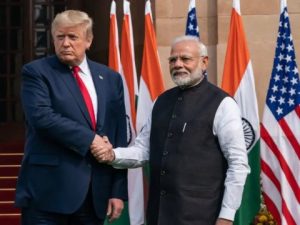Indian opportunity in China-Taiwan standoff

Photo credit Twitter spokesperson for Taiwan president
By Rahul Kumar Dubey
New Delhi, August 12: India may just have once in a century opportunity to transform into a technology and knowledge-based economy, as the world turns its back to China amid Beijing’s attempt to bully her neighbours.
Following military manoeuvres by the People Liberation Army, multinational corporations in Taiwan are planning to evacuate their people and assets. People’s Liberation Army’s (PLA) military manoeuvres have prompted some businesses to develop contingency plans or dust off old ones aimed to keep people and property safe in the wake of a possible conflict or military blockade.
For years, multinational corporations have reaped the benefits of the Asia-Pacific’s stable socio-political paradigms, allowing them to make prudent investment and business decisions in the region. The past events, however, such as US House Speaker Nancy Pelosi’s recent visit to Taiwan, show the region’s developing political fragility.
Following Pelosi’s visit to Taiwan, the PLA began encircling Taiwan with live-fire drills in waters close to Taiwan, thus inflicting a sense of instability in the minds of foreign investors in the region.
Companies in the United States of America with business in Taiwan are concerned about the implications of prospective Chinese military intervention against the self-governing island. The firms which come under the ambit of Fortune 500, as well as small and medium-sized businesses, are seeking the assistance of corporate security professionals to build contingency plans to protect their employees and assets if violence breaks out across the Taiwan Strait.

The fear of loss or seizure of assets in Taiwan as a result of a conflict is the driving force which is compelling the firms to take up such preventive measures.
Several companies are taking this very seriously because they do not want to see the implications of what happened in Russia, where they lost billions of dollars in financial and material assets, therefore they are already looking to relocate staff and assets to other nations. The Russian intervention in Ukraine has cost at least 37 multinational corporations between USD 100 million and USD 24 billion in losses.
An opportunity for India to harness the potential midst crisis
While multinational corporations in Taiwan are planning to evacuate their people and assets out of the country, it is a golden opportunity for India to invite the foreign investments in manufacturing sector, as India has proved itself as a preferred destination of foreign investments in the said sector.
The increase of FDI equity inflow in manufacturing sector by 76 per cent in FY 2021-22 (USD 21.34 billion) compared to previous FY 2020-21 (USD 12.09 billion) is a testimony of India’s capacity as a risk-free destination to attract investments.
It may be noted that FDI inflow has increased by 23 per cent post-Covid:
- March, 2020 to March, 2022: USD 171.84 Billion.
- February, 2018 to February, 2020: USD 141.10 Billion.
As far as the top recipient sector where FDI inflow was highest, ‘Computer Software & Hardware’ was at the top with FDI Equity inflow during FY 2021-22 around 25 per cent, followed by Services Sector (12 per cent) and Automobile Industry (12 per cent).
For instance, when the CoWin platform became global, it may have been the first time ever that a country made a software platform created by a public sector, available to the entire globe, demonstrating the tenacity of Indian IT companies.
After the conflict between Russia and Ukraine, the power equation in the world has changed, and business operations have moved past the regular stream. India is extremely important in two respects.
One is that Western and European investors have realised they cannot have complete control of the supply chain, and they must come to India because of its transparency and well-established legal system. Additionally, the Indian government is becoming considerably more receptive to inviting FDI.
The Government of India’s effectiveness have also increased over the years. Its improvements in public sector efficiency are mostly attributable to reasonably stable state finances despite the global slowdown owing to the pandemic and a positive attitude among Indian business players toward the financing, coupled with subsidies provided by the government to private companies. By 2025, India could be able to draw in FDI worth USD 160- USD 170 Billion annually.
Status of India’s FDI
One of the main forces behind economic growth in India is foreign direct investment (FDI), which serves as a source of non-debt financing for the nation. FDI injects long-term sustainable capital into the Indian economy which comes with several benefits such as technology transfer, growth of vital industries, increased thrust to innovation, competitiveness, and employment opportunities.
To create Atma-Nirbharata and foster creativity, the Government of India has undertaken a number of projects and policies. It is the persistent efforts of the government and business fraternity that the country has recorded highest ever annual FDI inflow of USD 83.57 billion in the Financial Year 2021-22.
In 2014-2015, FDI influx in India stood at 45.15 USD billion as compared to the highest ever annual FDI inflow of USD 83.57 billion, as calculated during the financial year 2021-22, surpassing last year’s FDI by USD 1.60 billion, despite adverse effects of military operation in Ukraine globally along with the aftershocks of the COVID-19 pandemic.
| Serial Number | Financial Year | FDI Inflow (In USD Billion) |
| 1. | 2018-2019 | 62.00 |
| 2. | 2019-2020 | 74.39 |
| 3. | 2020-2021 | 81.97 |
| 4. | 2021-2022 | 83.57 |
The government’s initiatives over the last eight years have paid off, as seen by the country’s record-breaking levels of FDI inflow that have been rising steadily. To keep India a desirable and welcoming place for investors, the government regularly analyses the FDI policy and occasionally makes substantial adjustments.
Most industries are now available to FDI via the automatic route, all thanks to the liberal and open FDI policy of the government. Reforms have recently been made in a variety of industries, including coal mining, contract manufacturing, digital media, single brand retail trading, civil aviation, defence, and insurance, to further liberalise and streamline FDI policy for the purpose of facilitating Ease of Doing Business and luring investments.
(Author is a researcher with Public Policy Research Centre)






